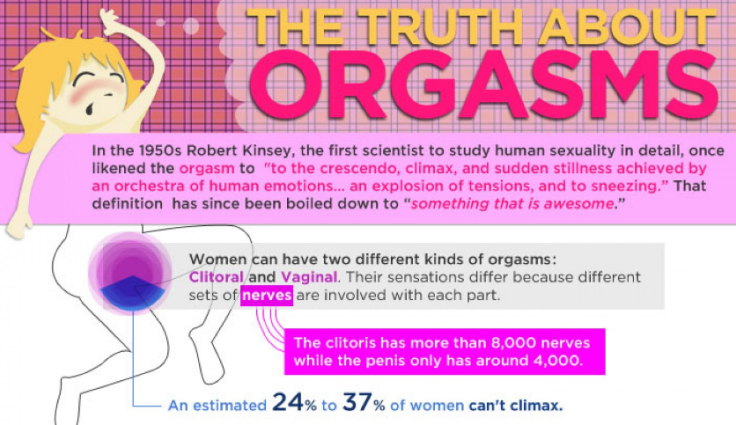The Big O: Everything You Need To Know About Orgasms For Better Sex

Clothes come off, kissing gets more passionate, and before you know it you're in the middle of "yes'ing" during the “big O” in the bedroom. As your grand finale is coming to an end (ahem), there's plenty that's happening within your mind and body that you probably don't know. Online School's infographic, "The Truth About Orgasms," lays down the facts about orgasms, from the part of the brain that's impacted by them to how long it takes other mammals to climax.
Despite the ink and verbiage on the complicated nature of the female orgasm, they're simple to understand. Women can have two different orgasms — clitoral and vaginal. Their sensations differ because different sets of nerves are involved in each part. A 2014 study found external clitoral stimulation did not involve the internal root of the clitoris. However, during vaginal stimulation, both the root and the external clitoris were involved. Whether a woman has a vaginal or clitoral orgasm, her body will physically react in the same way — heart rate, blood pressure, and breathing increase as she feels stimulation in her clitoris, and tension within her pelvis is released upon the orgasm.
Orgasms are both a mind and body experience. Portions of the brain impacted by orgasms include the nucleus accumbens, which controls the release of dopamine (the reward hormone), and the ventral tegmental area, which actually releases the dopamine. When we're aroused by close contact, our dopamine levels rise further, and at the time of orgasm, its effects are comparable to that of heroin on the brain.
So, why do we have orgasms?
Scientists believe it's a by-product of evolution like the male nipple. Speaking of, some people can orgasm from being touched there, while others have reported feeling orgasms in other parts of their body, including their hands and feet. Orgasms can even occur in limbs that aren't there anymore. Surprisingly, you can have orgasms even when you're dead if the sacral nerve is being oxygenated and electrically stimulated.
The number of orgasms and their duration often vary from person to person. However, there are women who suffer from Permanent Sexual Arousal Syndrome (PSAS), which increases blood flow to sex organs. Sarah Carmen, a patient who suffers from PSAS, is able to have 150 to 200 uncontrollable orgasms in a day due to her condition. The most female orgasms recorded by doctors were 134 within a single hour.
Similar to humans, bonobos and possibly dolphins have sex for pleasure. But the animal that has outshined us all is the pig; they have orgasms that can last for 30 minutes.
The science of orgasms is a concept scientists are still exploring.
Published by Medicaldaily.com




























